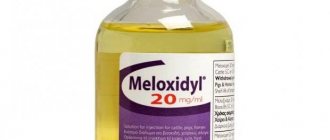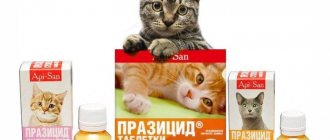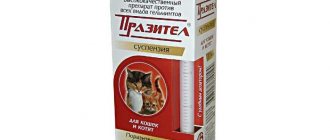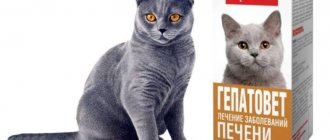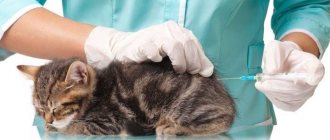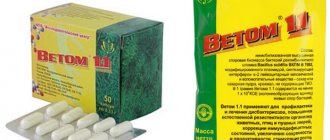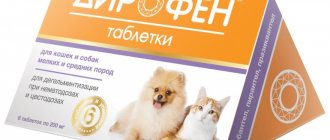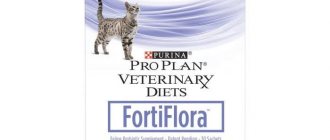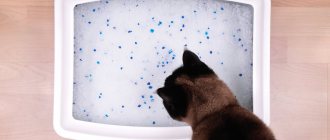The pharmaceutical drug "Meloxicam" for cats is used in cases where it is necessary to relieve the inflammatory process, relieve pain and reduce high body temperature. This most effective analgesic medication belongs to the group of NSAIDs (non-steroidal anti-inflammatory drugs) and, when used correctly, is characterized by excellent tolerability, minimal risk of developing side symptoms and the absence of the possibility of addiction to it. To determine the exact dosage of Meloxicam for a cat, breeders should consult a veterinarian.
Composition and properties
The medication consists of an active component - meloxicam and such excipients as:
- starch;
- sodium salt of citric acid;
- MCC;
- Aerosil;
- food emulsifier E572.
The instructions for use present Meloxicam as an anti-inflammatory, analgesic and antipyretic agent, which is sold in the form of a clear solution for injection and as a suspension. After use, the main ingredient of the medicine is localized at the site of pain and does not affect the gastrointestinal tract and kidneys. The breakdown of the medication is carried out in the liver, and it is excreted unchanged within 24 hours along with feces and urine. The principle of action of Meloxicam is based on the ability of its active substance to inhibit cyclooxygenase-2, which provokes inflammation and pain.
The principle of action of the drug
The therapeutic effect is provided by the main component of the drug - meloxicam . Its mechanism of action is its ability to suppress the synthesis of cyclooxygenase (COX), which produces inflammatory prostaglandins that cause inflammation, as well as swelling and pain.
Meloxicam is well absorbed from the intestines, as well as:
- already after 7 hours its concentration in the blood reaches the maximum norm;
- the drug accumulates in the liver;
- its main part (about 75%) is excreted in the bile in the form of a metabolite;
- the elimination period is just over a day;
- according to the degree of harm, it belongs to hazard class 4 (low-hazard);
- The therapeutic effect becomes noticeable already on the 3-4th day of use.
When is it prescribed?
In the process of numerous scientific studies, veterinarians were able to prove the effectiveness and safety of Meloxicam for cats.
If an animal suffers from joint dysplasia, the veterinarian may prescribe this drug.
A non-steroidal anti-inflammatory drug is indicated for use in cats when they are diagnosed with the following pathological conditions:
- various injuries;
- neoplasms;
- inflammation on the marginal part of the gum;
- inflammatory process on the mucous epithelium of the oral cavity;
- dermatological diseases, purulent skin lesions;
- cystitis;
- joint dysplasia;
- diabetic neuropathy.
Description
Loxicom for cats 15 ml bottle with two dispensing syringes oral suspension - a non-steroidal anti-inflammatory drug containing 0.5 mg of meloxicam as an active ingredient per 1 ml, as well as auxiliary components: sodium benzoate, glycerol, povidone K 30, xanthan gum, disodium phosphate dihydrate, sodium dihydrogen phosphate dihydrate, citric acid, simethicone emulsion and purified water. It is a white to light yellow suspension for oral use.
Instructions for use
Only a veterinarian can calculate the most effective and absolutely safe amount of Meloxicam for cats after a visual examination of the pet. Typically, treatment begins with a dosage of 0.1 mg per 1 kg of purring weight. From day 2, once a day they inject 0.05 milligrams per kilogram of the cat. An anesthetic suspension is indicated for fluffies in the first 24 hours at 0.2 mg/kg, and in subsequent days the dosage is reduced to 0.1 mg. The duration of the treatment course is at least 10 days. At the discretion of the veterinarian, the treatment regimen can be changed, but it is strongly not recommended for the breeder to make adjustments to dosages and set the duration of treatment on his own.
Possible restrictions
The drug is contraindicated in animals with a history of gastric and duodenal ulcers.
Despite the maximum safety of Meloxicam for cats, manufacturers provide a list of contraindications, in the presence of which the medicine should be discarded. Thus, a non-steroidal anti-inflammatory drug is not suitable for cats with individual intolerance to any component of its composition. In addition, you cannot use Meloxicam if your pet has been diagnosed with ulcerative lesions of the stomach and duodenum, hemorrhagic syndrome, or severe impairment of the functioning of the kidneys and liver.
You should not combine Meloxicam with glucocorticosteroids, anticoagulants and other non-steroidal anti-inflammatory drugs. Veterinarians do not prescribe this medication to lactating and pregnant females, kittens under 6 weeks of age, or purring cats with dehydration, low blood pressure, and reduced circulating blood volume. In exceptional cases and only at the discretion of the veterinarian, such animals may be prescribed Meloxicam, but only in a dosage half the usual one. It is strictly forbidden to treat cats with this medicine that have diseases of the cardiovascular system, there is a threat of developing stomach ulcers and gastrointestinal bleeding.
Suspension for oral use CEVA Meloxidil, 32ml.
Meloxidil is a non-steroidal anti-inflammatory drug and has anti-inflammatory, analgesic and antipyretic effects. Meloxidil is used in dogs to treat inflammation and relieve pain in acute and chronic diseases of the musculoskeletal system (arthritis, arthrosis, dislocations, edema, synovitis, tenosynovitis, etc.). COMPOSITION AND RELEASE FORM As an active ingredient, 100 ml of Meloxidil contains 0.15 g of meloxicam, and as excipients xanthan gum 0.20 g, anhydrous colloidal silicon 2.00 g, sorbitol 30.00 g, glycerin 16.00 g , xylitol 15.00 g, sodium benzoate 0.20 g, citric acid to pH 4.0 and water to 100 ml. In appearance, Meloxidil is a light yellow suspension. During storage, the formation of sediment is allowed, which, when shaken, forms a uniform suspension. Meloxidil is produced packaged in 10, 32 and 100 ml in polymer bottles of appropriate capacity, which are packaged in cardboard boxes and supplied with two measuring syringes, designed for dogs weighing up to 7 kg and dogs weighing more than 7 kg.
PHARMACOLOGICAL PROPERTIES Meloxidil is a non-steroidal anti-inflammatory drug (NSAID). Meloxicam, part of Meloxidil, belongs to the oxicam group of NSAIDs and has anti-inflammatory, analgesic and antipyretic effects. The mechanism of action of meloxicam is to suppress the production of cyclooxygenase (COX) in the arachidonic acid cycle, while the production of COX-II is predominantly suppressed, under the influence of which the synthesis of inflammatory prostaglandins (PGE1 and PGE2) occurs, causing inflammation, swelling and pain. After oral administration, meloxicam is well absorbed from the intestines of dogs and reaches its maximum plasma concentration within 7.5 hours, with a half-life of 24 hours. Meloxicam is metabolized in the liver and excreted in bile (75%) as a metabolite of glucuronic acid. In terms of the degree of impact on the body, Meloxidil is classified as a low-hazard substance (hazard class 4 according to GOST 12.1.007-76).
INDICATIONS Meloxidil is used in dogs to treat inflammation in acute and chronic diseases of the musculoskeletal system (arthritis, arthrosis, dislocations, edema, synovitis, tenosynovitis).
DOSES AND METHOD OF ADMINISTRATION Meloxidil is administered orally with food once a day at a dose of 0.2 mg/kg meloxicam on the first day of treatment, then at a maintenance dose of 0.1 mg/kg meloxicam for 10 days. Before use, shake the contents of the bottle until a homogeneous suspension is formed. Each package is equipped with two measuring syringes, which allows you to dose the drug as accurately as possible for small and large breeds of dogs. One division of a small syringe is designed for 0.5 kg of animal weight, a large syringe is designed for 2.5 kg of animal weight, which corresponds to a daily maintenance dose of 0.1 mg/kg of meloxicam. The clinical effect occurs 3-4 days after starting to use the drug. The duration of the course of treatment is determined by the veterinarian depending on the indications. After a 10-day course of treatment, the animal must be examined by a veterinarian and if there is no improvement in the clinical condition, the use of the drug is stopped. An overdose of Meloxidil in dogs by five times or more leads to dysfunction of the mucous membrane of the gastrointestinal tract (ulcers, gastritis), manifested by vomiting and diarrhea. In case of drug overdose, symptomatic treatment is recommended. The use of the drug in animals in a state of dehydration, hypovolemia and hypotension is potentially dangerous due to the possible toxic effect of meloxicam on the kidneys. In case of emergency, when prescribing Meloxidil to such animals, the daily dose should be halved and the clinical condition should be carefully monitored. If one or more doses of the drug are missed, treatment should be resumed as soon as possible in the prescribed dosage and regimen.
SIDE EFFECTS At recommended doses, the drug is well tolerated by dogs. In rare cases, possible: loss of appetite, apathy, vomiting, diarrhea, hidden blood in feces. Side effects usually appear in the first week of treatment and in most cases go away on their own after discontinuation of the drug.
CONTRAINDICATIONS Individual hypersensitivity to meloxicam, gastric and duodenal ulcers, hemorrhagic syndrome, severe cardiac, hepatic and renal failure, pregnancy and lactation, age up to 6 weeks.
SPECIAL INSTRUCTIONS It is not recommended to use Meloxidil in combination with other NSAIDs, glucocorticoids, diuretics, anticoagulants, aminoglycoside antibiotics and other drugs that are characterized by a high degree of binding to serum proteins due to the likelihood of increasing the toxic effect of the drug. If treatment with other NSAIDs is ineffective, Meloxidil is prescribed no earlier than 24 hours after discontinuation of the previous drug under the supervision of a veterinarian. The drug is not intended for the treatment of productive animals.
Personal preventive measures When working with Meloxidil, you should follow the general rules of personal hygiene and safety precautions provided for when working with medicines. When treating an animal with a medicinal product, contact with eyes and skin should be avoided; smoking, drinking and eating should not be allowed. If the drug accidentally comes into contact with the skin or mucous membranes of the eyes, they must be rinsed with water. People with hypersensitivity to NSAIDs should avoid direct contact with Meloxidil. If allergic reactions occur or if the drug accidentally enters the human body, you should immediately contact a medical facility (bring with you the instructions for use of the drug or the label). Empty bottles of the drug must not be used for household purposes; they are disposed of with household waste.
STORAGE CONDITIONS In sealed manufacturer's packaging, in a dry place, protected from light and inaccessible to children and animals, separately from food and feed at a temperature of 0°C to 25°C. Shelf life in unopened packaging, subject to storage conditions, is 3 years from the date of manufacture. After opening the bottle, the drug can be used for 6 months. It is prohibited to use the medicine after the expiration date. Unused drug is disposed of in accordance with legal requirements.
Read more
Negative effects
Correct use of the medicine is the key to successful and safe treatment. By neglecting the recommended doses and contraindications, the owner exposes the purr to various side symptoms. Thus, during therapy with Meloxicam, a cat may develop the following undesirable effects:
Drowsiness in a fluffy is a side effect of treatment with this drug.
- allergic reaction;
- drowsiness;
- cardiopalmus;
- blood pressure surges;
- abdominal pain;
- leukopenia;
- itching, rashes on the skin;
- swelling;
- disorders of the kidneys and liver.
If your pet shows signs of side effects from the medication, treatment should be stopped.
Long-term use of Meloxicam should be carried out exclusively under the supervision of a veterinarian. If an allergic reaction occurs in a cat, as a result of the body’s increased personal sensitivity to the components of the drug, treatment is stopped and the purr begins to be given antihistamines. The remaining symptoms usually go away on their own immediately after stopping the medication.
Similar medical products
If for some reason it is impossible to use Meloxicam, veterinarians replace it with another medication, but with a similar effect on the cat’s body. Thus, an absolute analogue is Meloksivet, which also belongs to the group of NSAIDs, but is also an antirheumatic drug, which makes it popular in the treatment of inflammatory diseases of the musculoskeletal system in cats. Meloksivet is also used to cure respiratory infections, in combination with antibacterial therapy in the fight against purulent catarrhal mastitis. Another analogue is the “Loxic” oral suspension, which is no less effective in relieving inflammation, relieving pain and normalizing body temperature.
